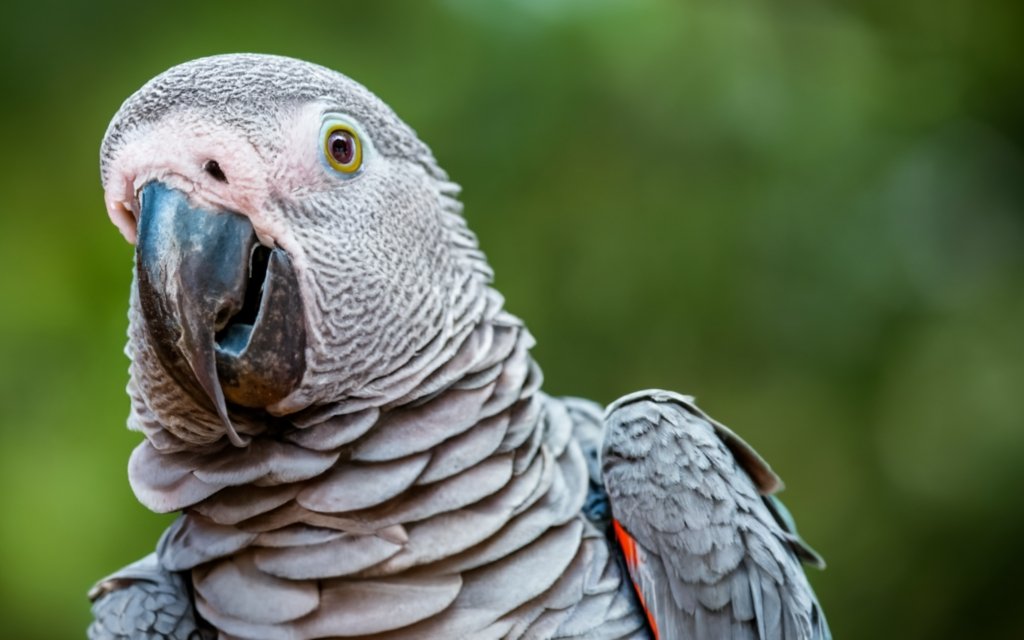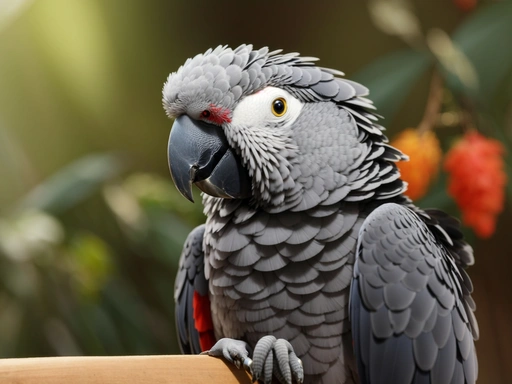How Do I Create a Safe Outdoor Space For My African Grey Parrot?
Key Takeaways:
- Provide a spacious and secure enclosure for your African Grey Parrot to prevent escape.
- Ensure plenty of natural sunlight and shade to mimic their natural habitat.
- Choose non-toxic plants and materials that can’t harm your parrot if ingested.
- Regularly clean and sanitize the outdoor space to prevent the spread of diseases.
Do you have an African Grey Parrot and want to provide them with a safe outdoor space to enjoy?
Creating the perfect environment for your feathered companion requires careful consideration of their needs.
From understanding their natural habitat to providing mental stimulation and ensuring safety, there are several factors to consider.
In this article, we’ll explore how you can design and maintain a safe outdoor space for your African Grey Parrot.
So, let’s dive in and discover how you can create a haven where your parrot can spread their wings and thrive!
| Pros | Cons | |
| 1. Cage | Provides a secure environment for your parrot Prevents escapes and predators Offers a familiar space for your parrot | May limit the parrot’s natural behaviors Can be a small and confined space for active birds |
| 2. Aviary | Allows for more freedom of movement Gives the parrot a larger living space Provides opportunities for natural behaviors | More expensive to build or purchase Requires a bigger outdoor area May expose the bird to potential predators |
| 3. Sunshade or Umbrella | Provides protection from direct sunlight Allows the bird to enjoy outdoor view and fresh air Can be easily moved around | May not provide enough shade on very hot days Needs constant supervision May blow away in strong winds |
| 4. Climbing Structures | Offers mental and physical exercise Simulates natural habitat Enriches the bird’s environment | Requires regular maintenance and cleaning Can become a potential hazard if not securely built May be challenging to install for some owners |
| 5. Safe Plants | Adds visual appeal to the outdoor space Provides foraging opportunities for the bird Can improve air quality | Some plants can be toxic to birds Needs careful selection to avoid harmful plants May require extra care for maintenance |
Understanding the Needs of African Grey Parrots
Understanding the needs of African Grey Parrots, such as their natural habitat, socialization requirements, and diet considerations, is essential for creating a safe and enriching environment for them.
The natural habitat of African Grey Parrots
African Grey Parrots are native to the dense forests of West and Central Africa, including countries like Ghana, Cameroon, and Ivory Coast. They thrive in habitats with a mix of trees, savannahs, and open areas.
These intelligent birds are highly adaptable and can be found in a variety of environments, from lowland forests to mountainous regions.
They rely on the forest canopy for protection and foraging, using their strong beaks to crack open nuts and fruits. The natural habitat of African Grey Parrots provides them with the ideal conditions for social interaction, mental stimulation, and access to a diverse range of food sources.
Socialization and mental stimulation requirements
African Grey Parrots are highly social birds and require regular socialization to thrive.
Interacting with your parrot through daily handling, playtime, and training sessions is essential for their mental well-being.
Additionally, providing mental stimulation through toys, puzzles, and environmental enrichment activities will keep them engaged and prevent boredom.
Choosing the Right Outdoor Space for Your African Grey Parrot
When choosing an outdoor space for your African Grey Parrot, prioritize safety and ensure it meets their specific needs.
Assessing the safety of your backyard or outdoor area
Assessing the safety of your backyard or outdoor area is essential to create a secure space for your African Grey Parrot.
Here are some key considerations:
- Remove any toxic plants or substances that could harm your parrot.
- Ensure there are no potential escape routes or gaps in enclosures.
- Check for any hazards like sharp objects, electrical wires, or chemicals.
- Keep an eye out for potential predators or animals that may harm your parrot.
- Consider the overall climate and temperature to provide a comfortable environment.
- Regularly inspect the area for any new risks or changes that could impact safety.

Designing an enclosure suited for African Grey Parrots
To design an enclosure suited for African Grey Parrots, consider creating a spacious and stimulating environment.
Incorporate natural perches and climbing structures for exercise, and offer toys and puzzles for mental stimulation.
Ensure the enclosure is escape-proof and protected against predators.
Use non-toxic plants and regularly inspect the space for hazards.
Finally, provide a comfortable temperature and climate for your parrot’s well-being.
Maintaining a comfortable temperature and climate
Maintaining a comfortable temperature and climate is crucial for the well-being of your African Grey Parrot. Provide shade and shelter to protect them from direct sunlight and extreme weather conditions.
Keep the temperature moderate, avoiding extreme heat or cold.
Regularly monitor and adjust the environment to ensure your parrot’s comfort.

Providing Enrichment and Entertainment
To keep your African Grey Parrot entertained, incorporate natural perches and climbing structures.
Additionally, offer toys and puzzles for mental stimulation and create opportunities for foraging and playtime.
Incorporating natural perches and climbing structures
Incorporating natural perches and climbing structures in your outdoor space is essential for the health and well-being of your African Grey Parrot.
Provide sturdy branches of varying thickness for perching, as well as ropes or ladders for climbing.
Natural materials like wood are preferable over synthetic options.
Offering toys and puzzles for mental stimulation
To keep your African Grey Parrot mentally stimulated, offer a variety of toys and puzzles.
Include interactive toys that require problem-solving, such as foraging toys, puzzle feeders, and treat-dispensing toys.
Rotate the toys regularly to maintain interest and provide a stimulating environment.
Creating opportunities for foraging and playtime
To create opportunities for foraging and playtime for your African Grey parrot, you can:
- Scatter food around the enclosure or hide treats in various toys to encourage natural foraging behaviors.
- Provide a variety of toys, such as puzzle feeders, for mental stimulation and problem-solving.
- Use foraging wheels or puzzles that require your parrot to manipulate objects to access treats.
- Rotate toys regularly to keep your parrot engaged and prevent boredom.
- Incorporate branches, ropes, and ladders to create climbing and perching opportunities.
- Offer safe, chewable toys to satisfy your parrot’s natural desire to chew.
- Monitor your parrot’s behavior and preferences, adjusting toys and activities accordingly.
Ensuring Safety in the Outdoor Space
Creating a safe outdoor space for your African Grey Parrot involves using non-toxic plants, preventing escape and protecting against predators, as well as regularly inspecting the area for hazards.
Using non-toxic plants and avoiding harmful substances
When designing your outdoor space for your African Grey Parrot, it’s important to choose non-toxic plants and avoid harmful substances. Some common toxic plants include lilies, azaleas, and philodendrons.
Opt for bird-safe plants like African violets, hibiscus, and marigolds.
Avoid using pesticides, herbicides, and fertilizers that may be toxic to your parrot. Always research any new plants or substances before introducing them to your parrot’s environment.

Preventing escape and protecting against predators
To prevent escape and protect against predators, it’s important to ensure your outdoor space is secure. Use strong and sturdy fencing with small gaps to prevent your African Grey Parrot from squeezing through.
Consider adding an apron or burying wire mesh around the enclosure to deter predators from digging underneath.
Regularly inspect the fencing for any weak spots or damage.
Introducing Your African Grey Parrot to the Outdoor Space
To introduce your African Grey Parrot to the outdoor space, start with gradual acclimation and supervised introductions. Use positive reinforcement and training techniques to create a positive association with the outdoor environment.
Monitor your parrot’s behavior and make adjustments accordingly.
Gradual acclimation and supervised introductions
To ensure a smooth transition for your African Grey Parrot to the outdoor space, gradual acclimation and supervised introductions are key.
Start by introducing your parrot to the outdoor area in short intervals, gradually increasing the duration over time.
Always supervise your parrot during these introductions to ensure their safety and monitor their behavior.
Positive reinforcement and training techniques can also be used to encourage your parrot to explore and enjoy their new outdoor environment.
Using positive reinforcement and training techniques
Positive reinforcement is key when training African Grey Parrots.
Reward desired behaviors, such as stepping onto a perch or speaking a word, with treats or praise.
Use a clicker to mark the behavior you want to reinforce.
Consistency and patience will help your parrot learn and thrive.
Monitoring behavior and adjusting accordingly
Monitoring behavior is crucial when introducing your African Grey Parrot to the outdoor space.
Observe their reactions to the new environment, paying attention to signs of stress or discomfort.
Adjust accordingly by providing additional stimuli, modifying the enclosure, or scheduling shorter outdoor sessions.
Regular observation and adaptation will ensure a safe and enjoyable experience for your parrot.
Frequently Asked Questions
Can African Grey Parrots be kept outdoors all year round?
No, African Grey Parrots should not be kept outdoors all year round. They are sensitive to temperature changes and require a stable, controlled environment.
It’s best to provide them with a safe and enriching indoor space that meets their specific needs.
How do I protect my African Grey Parrot from extreme weather conditions?
To protect your African Grey Parrot from extreme weather conditions, it’s important to provide shelter and regulate the temperature.
You can use a well-insulated outdoor aviary or a covered enclosure to shield your parrot from excessive heat, cold, wind, or rain.
Additionally, consider using heat lamps or fans to control the temperature and humidity levels.
Regularly monitor the weather and make adjustments accordingly to ensure your parrot’s safety and comfort.
What plants are safe to have in the outdoor space for my parrot?
When it comes to selecting plants for your parrot’s outdoor space, it’s important to prioritize safety. Some safe plant options for African Grey Parrots include:
- Fruit-bearing trees: Such as apple, pear, and peach trees, which can provide your parrot with fresh snacks and entertainment.
- Non-toxic shrubs and flowers: Examples include hibiscus, marigolds, and roses, but always double-check the specific variety to ensure it is safe for birds.
- Herb garden: Growing herbs like parsley, basil, and dill can provide your parrot with additional dietary options and sensory stimulation.
- Non-toxic climbing plants: Consider adding vines like passionflower or jasmine to provide natural climbing opportunities for your parrot.
- Grasses and native plants: Native grasses, such as Bermuda grass or Bahia grass, can create a natural environment for your parrot to explore.
Remember to always thoroughly research any plant before introducing it to your parrot’s outdoor space to ensure it is safe and non-toxic.
Is it necessary to provide shade in the outdoor space?
Yes, it is necessary to provide shade in the outdoor space for your African Grey Parrot.
These birds are sensitive to extreme temperatures and can easily overheat in direct sunlight.
Shade will help protect them from the heat and ensure their comfort and well-being.

Final Verdict
Creating a safe and enriching outdoor space for your African Grey Parrot is essential for their overall well-being and happiness.
By understanding their natural needs, designing a secure enclosure, providing enrichment and entertainment, and ensuring safety measures, you can confidently introduce your parrot to outdoor experiences.
Remember to acclimate them gradually, use positive reinforcement, and monitor their behavior closely.
With careful planning and attention to detail, you can create a space where your African Grey Parrot can thrive and enjoy the outdoors while staying safe.







